Let's get right to the point: Metroid Prime is the best GameCube game to date. It's one of the best games on any platform this year, and, for good measure, it's also the best game yet in Nintendo's highly acclaimed Metroid series. Many were rightfully skeptical about whether an unknown Texas-based developer could take the classic open-ended, side-scrolling action adventure gameplay formula of the Metroid series and successfully translate it into 3D. And these are the people who will no doubt come away most impressed of all with Metroid Prime, which is in every respect a pure and true successor to the series of games that inspired it. At the same time, those who have never played a Metroid game before are likely to be just as taken with Metroid Prime. This first-person action adventure game is filled with so much detail, style, and originality that literally every gamer should play it.

It's not a first-person shooter. Metroid Prime doesn't play like any other game that's come before it, and it emphasizes exploration and investigation at least as much as pure action. So the pacing is deliberate at times, though the going is never slow. As in all other Metroid games, you'll assume the role of interstellar bounty hunter Samus Aran, whose objective this time out is to search the planet Tallon IV for signs of illicit activity on the part of the Zebesian space pirates and put a stop to them once and for all. Clad in her distinctive red-and-gold power suit, Samus is a self-sufficient and versatile, and controlling her is quite a bit different from what you may be used to in first-person games.
Don't expect some sweeping space opera of a story. This game draws you in not with storytelling but with a vast, seamless 3D world that sprawls out in front of you in all directions, just waiting for you to discover all its many secrets. These secrets are justified: Samus' unique body armor was crafted by a mysteriously vanished race of birdlike scientist-philosophers who colonized Tallon IV and hid away its greatest treasures for their own kind. All this is suggestive of one of the most impressive accomplishments of Metroid Prime: It never breaks you out of the experience of the game. The far-flung futuristic technology and the imaginative alien world come across as surprisingly believable.
While Metroid Prime isn't plot-driven, it provides you with lots and lots of context. One of the game's key mechanics is Samus' ability to switch between a number of different "visors," which are essentially different types of heads-up displays. Her default view, the combat visor, provides a clear, straightforward picture of her surroundings and features a helpful radar display for tracking enemy movement. In this mode, Samus can easily target and accurately fire upon any enemies in the vicinity. Meanwhile, the other visor she starts out with requires her to lower her weapons, but it allows her to analyze various objects of interest, from Tallon IV's numerous alien creatures to environmental anomalies to alien technologies. You scan objects the same way you'd normally target them: by pressing and holding the controller's left shoulder button, which commences a quick scan that then reveals key information using concisely written text. Objects that can be scanned are denoted with colored icons visible only in scanning mode, and truly important objects are clearly highlighted, effectively giving you the option to bypass all the other unknown items of lesser import.
While the notion of reading pseudo-scientific text while playing Metroid Prime may not sound very appealing, it actually works pretty well as a sort of storytelling device. When you eventually raid the space pirates' stronghold, you'll feel a chill as you read about their various genetic experiments and look over their reports on the damage you've caused. Also, scanning enemies generally clues you in on whatever weaknesses they may have, though it's a bit odd that the action pauses for your reading convenience. Every new creature species or other important piece of information you scan is stored in a logbook, and you'll likely enjoy reviewing this material every now and then, since it's all written using such a cohesive style.
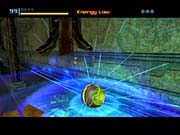
In addition to her combat visor and scan visor, Samus will eventually find a thermal visor used for detecting heat signatures of living creatures or energy sources and an X-ray visor used for detecting illusions or incorporeal objects. You can easily switch between the four visors by pressing different directions on the D pad, and you can likewise switch between your four different primary weapon modes (assuming you've found them all) by pressing in different directions using the controller's right analog stick. The classic Metroid weapons are all here. Samus' default semiautomatic power beam rapidly fires bursts of superheated energy. Her wave beam's electrical charge is especially good at disrupting energy-based opponents or triggering long-dormant energy sources. Her ice beam can freeze foes in their tracks, making them brittle enough that they can be shattered. And her plasma beam shoots intensely hot lavalike rays that can disintegrate victims on the receiving end. Samus gains the ability to charge up an especially powerful blast from each of these weapons, and she can also fire a limited number of ballistic missiles that can be combined with any of the main weapons for a number of extremely damaging special attacks. Unlike in previous Metroid games, none of Samus' weapons are ever replaced--her arsenal only grows in size, and all her available armaments remain tactically useful throughout the game.
The rest of Metroid Prime's controls do an excellent job of capturing the classic feel of the Metroid games in full 3D and, in their own right, of simulating what it might be like to be in Samus' armor-plated boots. The left analog stick is normally used to move forward and backward and turn left and right. Strafing from side to side is accomplished by holding the left trigger in while moving the analog stick in the desired direction, while looking up or down is handled by holding the right trigger in while moving in the desired direction. This may seem a bit awkward at first, but it's intentionally so. You'll actually see Samus clasp her free hand on her blaster when she aims up or down, and she has some difficulty craning her neck all the way forward or back, as well she should in that hefty suit of hers.
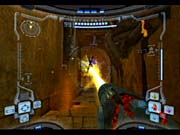
That's not to say Samus is sluggish or ungainly. In fact, she has all the grace, poise, and skills that made 1994's Super Metroid such a great game to play. While targeting a foe, she can perform quick lateral evasive leaps to stay out of harm's way, and her own aim is almost flawless. The typical first-person shooter challenge of manually targeting enemies really isn't a consideration in Metroid Prime, as Samus' integrated targeting systems aim for you at the touch of a button. For this reason, even from the get-go, you'll distinctly get the impression that Samus is very powerful, and that few enemies could stand toe-to-toe with her. This makes sense, as she didn't become an interstellar bounty hunter for nothing. But fear not, because Samus will assuredly have to contend with some extremely strong adversaries, many of which require some vastly different tactics to defeat. Some of Metroid Prime's enemies are throwbacks to previous games in the series. Notably, you'll get to square off against the jellyfish-like metroids, which will latch onto you and drain your energy if you aren't careful. The space pirates also make for some fine adversaries, as these hulking, mantislike creatures come in a number of dangerous varieties and can be quite clever in a fight. You'll also engage in some memorable, protracted battles against a number of big, tough boss monsters--another signature element of the series.
Just as Metroid Prime focuses equally on action and exploration, so does its challenge equally stem from dangerous enemies and environmental obstacles. For one thing, Samus will need to do a lot of jumping to get where she needs to go. Jumping mechanics are notoriously bad in almost every single first-person game, but Metroid Prime miraculously bucks this trend. It's difficult to explain precisely why the jumping in Metroid Prime feels so right. Part of it is that Samus' perspective automatically tilts slightly with the trajectory of her leap, a logical touch that frees you from ever having to adjust your perspective in midair. Another part of it is that Samus naturally jumps high and far, especially once she upgrades her jumping ability, so that suddenly she's able to make leaps that are huge and dramatic but still controlled. Yet another part of it is Metroid Prime's level design, which is so exceptional that calling it "level design" seems almost derogatory.
In fact, the game has no levels. It's all one vast, continuous world that somehow manages to blend numerous, starkly different environments, from lush tropics to dusty caverns to frigid fields of ice to hellish lakes of fire. Metroid Prime has no loading times whatsoever, not when you first turn on your GameCube, and not when you run through miles of Tallon IV's incredibly detailed vistas. Using a classic convention of the Metroid series--areas of Tallon IV are walled off by iris-shaped doors that must be shot open using your beam weapons--the game manages to quietly, invisibly stream new content in the background as you move along. This is similar to a technical feat first seen in Crystal Dynamics' imaginative Soul Reaver games, only Metroid Prime's environments are even more detailed and the background loading is even more transparent than in those games.
The benefits to there being no loading times in the game cannot be overstated. One way to put it is, after playing Metroid Prime, you may find that most level-based games seem somehow primitive to you. At any rate, the sheer size, the remarkable detail, and the continuous nature of Metroid Prime's setting are huge parts of what makes the game so fantastic. You'll see tremendous variety in the scenery, from tight, claustrophobic corridors to flooded passageways to vast, elaborate temples, and it all looks natural and lifelike and yet isn't confusing or bewildering. When you can jump to reach a certain area, you'll know. When something is out of your reach, you'll know why. How the designers were able to make environments that have a natural feel and yet are easy to explore without seeming contrived is an utter mystery. One thing's for certain: The designers at Retro Studios are extremely talented.
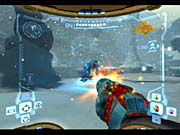
Metroid Prime has as much variety in its gameplay as it does in its environments. Metroid fans will be thrilled to find that the mechanics of Samus' morph ball ability are more enjoyable here than in any previous game in the series. At the same time, those unfamiliar with Metroid will be really surprised when they first see Samus roll up into a perfect sphere that can hurtle about like a living bowling ball. Samus can switch to morph ball mode at any time, causing the game to casually switch to a third-person point of view, in which Samus can move about very quickly or creep her way into otherwise inaccessible areas. She'll learn to drop energy bombs in morph ball mode, and fans of the classic games will be overjoyed to find that she can still use those bombs to propel herself in different directions, or even to juggle herself high into the air by detonating bombs with proper timing. Later, she'll even gain the ability to ride along magnetic rails up walls, onto ceilings, and all around. Like some space-age skateboarder, she'll even be able to use her momentum to roll higher and higher up what are honest-to-goodness half-pipes. Samus' ability to roll up into a ball has always been one of the strangest, most distinctive parts of the Metroid series, and in Metroid Prime, the morph ball makes for some of the game's most amusing and most surprising moments.
Considering the vastness of Tallon IV, finding your way around is surprisingly manageable. By pressing the Z button at any point during play, you can call up a 3D map of the area that, at first, looks terrifying, with winding passageways veering off in every direction. Yet you'll find that this 3D map is in fact very effective, clearly displaying your position in the area, all possible (unhidden) exits to other areas, and key points of interest that you've either discovered or whose location you've downloaded. The game's plot, such as it is, moves along as you receive sporadic updates that encourage you to head off to previously unexplored regions. So the early going is actually fairly linear, though you always have the option to put off your next objective and see what you can find off the beaten path. But you might as well wait until later on in the game when you're well equipped with all of Samus' various powers, which let her explore quickly and efficiently. The gameplay really opens up toward the end, as once you've essentially gotten all of Samus' powers, you'll then have to use them to explore places you've already been to, only with the intent of uncovering things that you didn't even know were there the first time through. It would have been nice if the map allowed you to plot waypoints, but it still greatly facilitates your exploring.
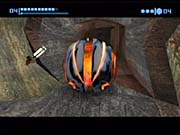
Ironically, the criticisms that can be leveled against Metroid Prime are associated with certain conventions that are integral to the Metroid series and must have been deliberately put into this game to keep things faithful. For instance, the notion of having to backtrack through previously explored areas has grown unpopular with gamers over the years, and yet backtracking is certainly required in Metroid Prime. But this is a good kind of backtracking--you'll reenter the same areas from different directions and equipped with vastly different abilities, and you'll enjoy blasting to smithereens those same enemies that caused you a lot more trouble your first time through. That's another thing, actually: Just like in past Metroid games, enemies in Metroid Prime respawn soon after you leave an area. It's not necessarily realistic that your foes will keep reappearing, but it does keep things lively. Additionally, all the jumping, even though it's done so well, will be a sticking point for some, mostly for those who approach Metroid Prime as a shooter and not as an action adventure. These players should at least appreciate that Samus never sustains damage from falling (another Metroid convention) and that there are no do-or-die jumps in the game. If you fall, you can try again. The lack of any real narrative might also disappoint some players, and finally, someone, somewhere will complain that Metroid Prime has no multiplayer features. But we'll leave that for someone, somewhere to complain about, since it's hardly relevant.
Metroid Prime grows on you as you play. For instance, at first you might not see what's so remarkably impressive about its visuals, since Metroid Prime at first looks like any old sci-fi-themed shooter. But then you'll start to see more and more amazing little details. You'll see water streak down Samus' visor when she emerges from a lake. You'll see light seem to bend into the intense radiation of the supercharged energy blasts from her beam weapon. You'll see Samus' own face reflected in her visor when there's a bright flash of light nearby. And you'll even see the skeletal frame of Samus' hand toggling switches within her blaster when you change primary firing modes while using the X-ray visor. These are subtle points that you'll deeply appreciate rather than overlook. You'll also continue to wonder at how the game manages to produce such vivid landscapes without stopping to load them. Crisp, clean textures and complex geometry can be seen throughout, and while not all the graphics are jaw-dropping, all the little things add up to give the game an unparalleled visual presentation. For good measure, Metroid Prime supports progressive-scan displays.
It also supports Dolby Pro Logic II setups for some great surround sound. Though the visuals are spectacular and really pull you into the experience, the game's audio also makes a significant contribution to Metroid Prime's atmosphere. There's no speech whatsoever, but a large variety of sound effects accompany all the various weapons, creatures, and environments that you'll see. Some of the creatures sound really menacing, and the weapons shriek with the sort of intensity you'd hope for. But the environmental audio is probably what's best. The game is loaded with hidden items that boost Samus' missile capacity, energy capacity, and more, and you'll learn to listen for the distinct low whirring that signifies the proximity of these objects. To actually find these items, you'll often have to switch visors, but the thermal and X-ray visors make their own noises that all but drown out the ambient sound of the power-up. At any rate, sound is a critical part of the game. Metroid Prime's musical score is also by and large very successful. Though the tracks are heavily synthesized and sound as though they could have come from 1994's Super Metroid, they help evoke suspense, intensity, calm, or panic mostly at all the right moments. Metroid fans will also really appreciate that a majority of the game's music actually consists of remixed tracks from previous installments in the series.
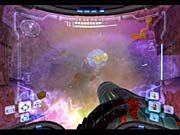
Metroid Prime is a lengthy game that should take approximately 20 hours to finish the first time through, though you could easily spend a lot more time in the game trying to find everything that's hidden away. Successfully completing Samus' mission unlocks a harder difficulty mode in which enemies are considerably tougher, and chances are you'll want to give this tougher setting a shot. Furthermore, those who own a Game Boy Advance, a GameCube-to-GBA link capable, and a copy of Metroid Fusion (an original GBA Metroid game released simultaneously with Metroid Prime) can unlock a couple of other nice features. One is a real treat: a straight port of the original 1987 Metroid game, which actually holds up pretty well. Another is purely cosmetic, allowing you play through Metroid Prime in Samus' funky yellow-and-fuchsia suit from Metroid Fusion. But you shouldn't need these extras to compel you to play Metroid Prime. It's not just one of the single most atmospheric games ever created, but it's also quite simply one of the best.